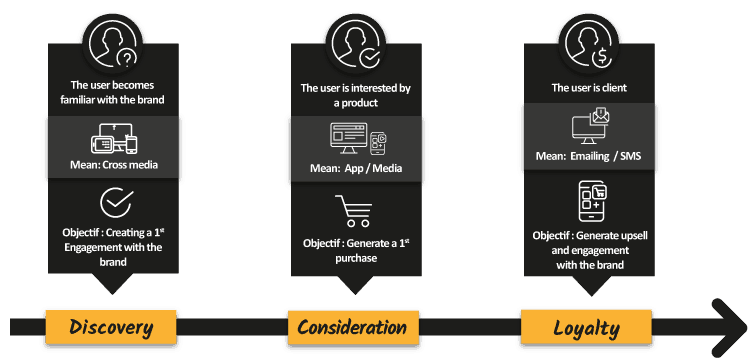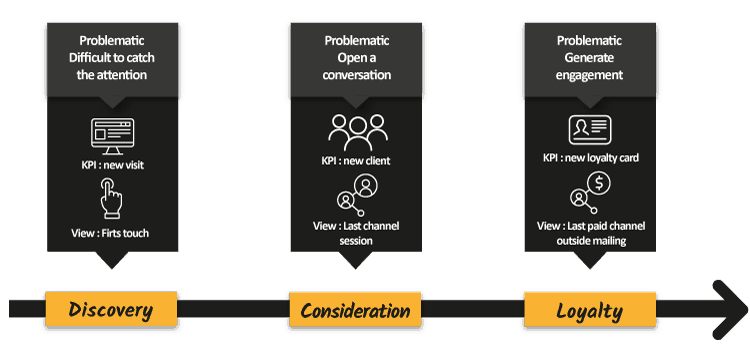Home > Blog > Consigli > Dall’attribuzione… a una strategia di attribuzione
According to a study by the Boston Consulting Group [1], companies offering their customers personalized experiences see their revenues increase by 6% to 10%, two to three times faster than those that do not. This insight, coupled with the reality of a growing technological offer to personalize media actions at each stage of the customer journey, implies an evolution of advertisers’ marketing strategy. They are moving towards a people-based strategy, based on data, adapted to the Customer Journey. This strategy of marketing attribution in the making tends to definitely highlight the obsolescence of the Last Click.
Attribution White Paper, understand the challenges. Download it now!
The relationship must be personalized at each stage of the Customer Journey, with appropriate media partners and objectives consistent with their missions:

Customer Journey & Attribution Strategy
As the marketing strategy is deployed on the Customer Journey, there is no time left to lose to adapt our attribution strategy.
It will therefore aim to enhance the partners who create engagement at each stage of the Customer Journey, in accordance with the given objective. For example: a branding partner will be evaluated via an attribution valuing the engagement generated during the discovery phase. A retargeting partner will be evaluated on its ability to finalize the consideration phase.
But a question arises: how to set up an attribution strategy?
By combining KPI and attribution view in a way adapted to each stage of the Customer Journey!
A step by step attribution strategy
The discovery phase is probably the most difficult to understand: users are overexposed, the competition is tough and it is difficult to catch the attention. The typologies of branding campaigns will aim to create a first engagement, an adapted KPI could simply be a new visit or a unique new visitor (UNV). The attribution view could be a “first touch” or ” Last branding Search deprioritizing channel ” if you consider that this interaction generating a visit will have been heavily influenced by a previous interaction awakening to the brand.
The user then enters the consideration phase. A first interaction took place with the brand following a first visit. The retargeting campaigns then come into action and seek to bring our user to a 1st conversion. The new client KPI then seems quite adapted. It can be refined to notions of turnover or margins. A “Last Session channel” attribution view can be useful for assigning conversion to the channel that created the session leading up to the sale. The strategy could even be refined on intermediate objectives like the lead or the cart.
Our user is now a client. He enters the loyalty phase! Everything remains to be done to make the media investments profitable to recruit: to generate engagement, upsell … The stakes are strong! The attribution strategy can then take multiple forms according to the set CRM objectives and the KPI combination / duplicated attribution view: download of app, second purchase, subscription to a loyalty card … You choose!
Depending on your Mix Media, you may also decide to deprioritize the mailing to have an enhancing view of paid marketing channels.

Attribution is also patience. Your attribution strategy can evolve into a single attribution view, thanks to the Multi-Touch Attribution. This step could however be premature if it was based on a historical attribution to the last click.
Combining KPI and Single Touch attribution view is still a reasonable first step to interpret both the new insights you have at your disposal and better understand the future goals that will define your next attribution data-driven model.



